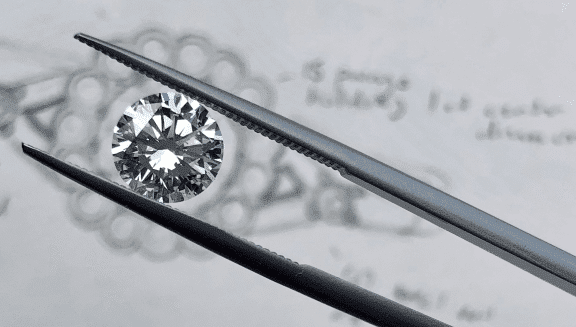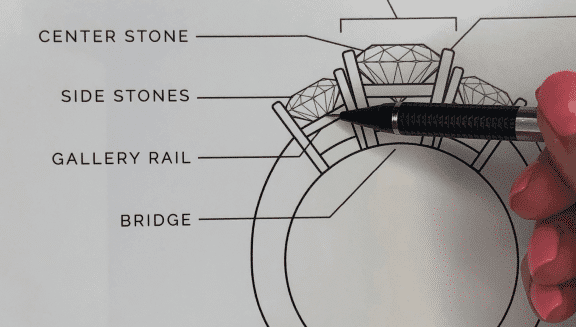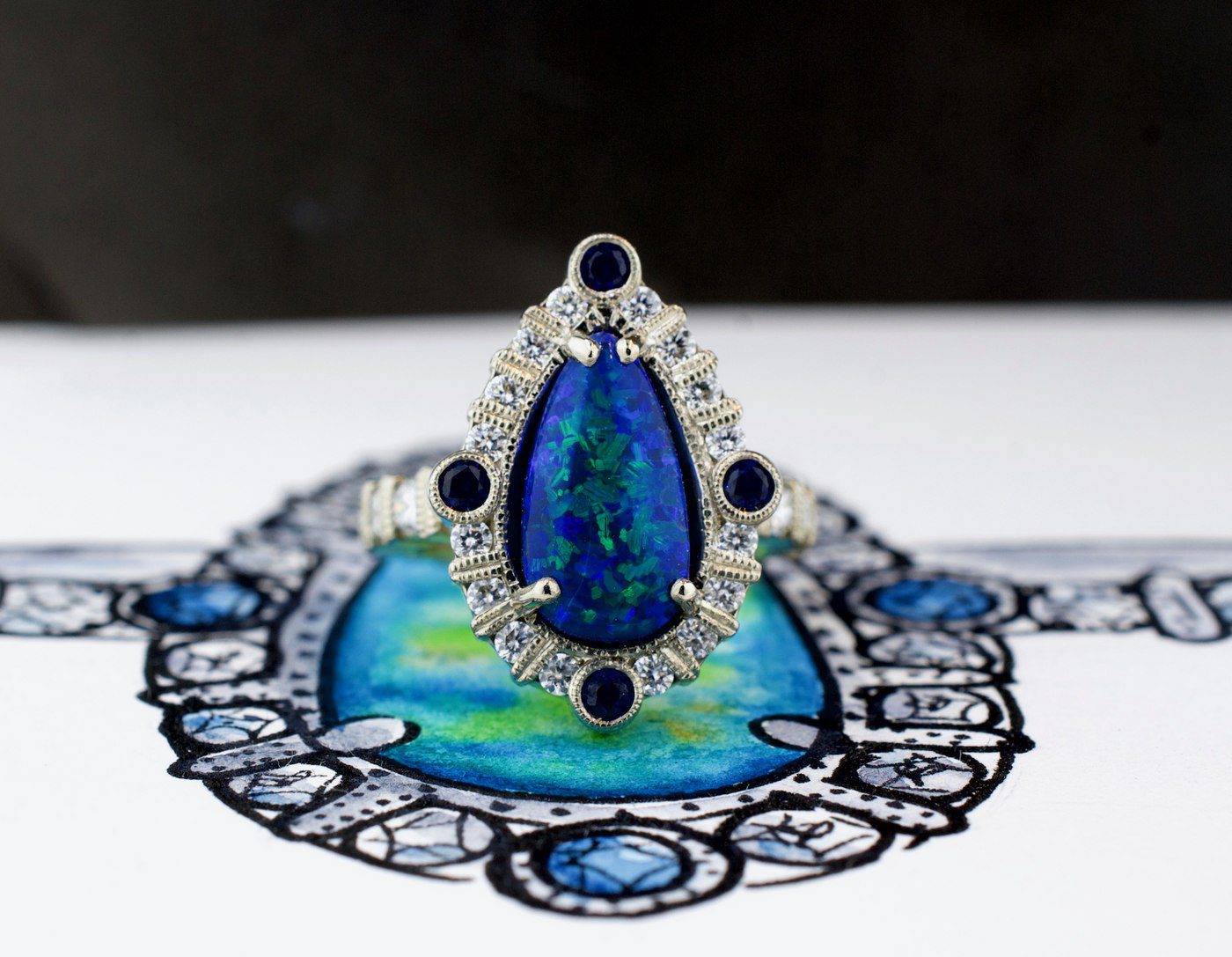The Hard Truth About Trendy Engagement Rings
Curious about those trendy iridescent moonstone engagement rings? What about the cool southwestern vibe of turquoise in yellow gold? As a custom jewelry designer, lots of clients come to us wanting chic, unconventional center stones like moonstone, opal, pearl and turquoise. While we love these magical stones for their beauty and mystique, we hate to see anyone save up for an engagement ring that breaks within a year or even less. There’s a reason why these gemstones have taken a backseat to traditional gems for so many centuries. Before you buy that trendy ring, you need to know what you’re getting yourself into. Luckily, there’s a universally accepted scale that will help you make that decision.
What is a Trendy Engagement Ring?
A trendy engagement ring is one made with intention of looking great and being on trend with what is happening right now. The ring may have a beautiful design or a fashionable setting, but it might not be built to last. With an increase in online jewelry stores, we are seeing more and more rings being marketed as “engagement rings”that are fashion jewelry, not fine jewelry. Lately, it has been common to see super thin, delicate shanks, bands, and prongs on rings – and although we love this dainty look, it makes it likely for the ring to bend and break. This sort of design is simply not engineering to be worn every day. So remember that just because a piece of jewelry looks beautiful, sparkly, and has a high price tag, does not mean that it’s made to be worn every day. If you’re in doubt when it comes to specific stones, look at the Mohs Scale of Hardness. For engagement rings, we recommend hardness of at least a 7 or higher.
The Mohs Scale of Hardness
The Mohs Hardness scale (pronounced “moze”), is a scale used for identifying gems and minerals based on their “hardness”, or resistance to being scratched. As gems and minerals from the same family have a pretty consistent hardness across the board, it is incredibly effective and has been used for centuries by jewelers and geologists alike. The Mohs Scale was developed in 1812 by German geologist Friedrich Mohs. To measure mineral hardness, he selected ten minerals of distinctly different hardness levels that ranged from very soft (talc) to very hard (diamond). He then attempted to scratch one mineral with the other. If mineral A was scratched by mineral B, then mineral B is harder than mineral A and so on, until a scale of hardness was determined. If neither mineral would scratch each other, or made very small insignificant scratches, then those minerals were the same hardness. Mohs’ findings for the original 10 gems and minerals he tested are pictured below and are still the undisputed authority today.

(The Mohs Scale of Hardness.)
When looking at The Mohs Scale, it’s important to note that while all stones and minerals are equally spaced between numbers, the difference in hardness is not equally distributed across stones. Diamonds and corundum (rubies and sapphires) are right next to each other on the hardness scale, but you can see a really sizable difference in hardness, with diamonds hardness more than doubled when compared. For most people, this can be a real wake up call. Many believe that diamonds became the norm for engagement rings because of clever marketing, but it’s really for practical reasons: diamonds are the hardest natural substance on earth, and engagement rings go through a lot of potentially damaging situations within a lifetime of wear.

(Diamonds are the hardest natural substance on the planet, making them the most durable, reliable stone).
Why Does the Mohs Hardness Scale Matter?

(Hard as a rock: The Hillary black diamond engagement ring).
Jewelers like us reference the Mohs Scale because it helps determine which gems and minerals are the best to use when making jewelry that will last forever. The harder a stone is, the more able to handle the wear and tear of everyday tasks without being scratched. For a soft stone, everything from putting your hand in your pocket to accidentally tapping it against your car door can leave a lasting scratch. If you want your engagement ring to survive a lifetime, it’s important to consider the hardness of the stones that you use and how that will affect how you wear your ring. If you’re dead set on a trendy moonstone engagement ring or other soft gemstone, you should only wear it for special occasions Which is not the best news for most brides-to-be. After you get the ring, you want to wear it 24/7, show it to as many people as possible, and stare at it all the time. Do this with a vulnerable stone and it probably won’t last very long – leaving you with a ruined engagement ring, or worse none at all.
Mohs Scale of Hardness and Gemstones

Photo courtesy of Estate Diamond Jewelry.
So you know that diamonds are the most durable choice for engagement rings, but what if you don’t want a diamond? Sapphires and rubies are the next best bet. Both of these stones have been used in jewelry for millennia, and continue to be for a good reason: they last. Though blue is the most well known color for sapphires, they actually come in all colors of the rainbow and different levels of clarity. You can find the milky color of a moonstone or pearl, or the greenish/blue hue of turquoise. At Abby Sparks Jewelry, we can source stones for you based on the look you want to achieve. If you’re still considering a trend-forward gemstone that’s at 6 or lower on the Mohs Scale, it’s imperative that you work with a skilled jewelry designer who will create a super secure setting to best protect your stone and give it the best shot at a longer life.
Metals
At our studio, we often see couples unsure about what type of metal they should choose for an engagement ring. Although there are many great options to choose from, there are few you should avoid. 18 karat gold in rose, yellow, and white, is much softer than 14 karat gold and it is unable to withstand a lot of pressure. It is also common to see people choose sterling silver for their engagement ring in order to save money, but trust us, you’ll pay for it in the end. These metals are not durable enough to hold a tough, hard stone, like a diamond or moissanite, and there is a good chance you’ll end up needing a new engagement ring. So, what should you opt for? We like 14 karat gold (yellow, white, and rose), palladium, and platinum. These metals are tough and durable.
Diamond and Gemstone Durability
(The Courtney sapphire sunburst engagement ring set with both a sapphire and diamonds).
Beyond gem hardness, jewelers also rate diamonds and gemstones on their overall durability, including toughness, resistance to breaking or chipping, and stability, or resistance to temperature changes and household chemicals. Stones such as diamonds and sapphires rate high on this scale, however a very strong blow still has the possibility of chipping your stones. No engagement ring is indestructible.

(The Amanda opal engagement ring, before wear).

(The Amanda opal engagement ring after long-time wear).
Stones like opals, moonstones, and pearls rate very low in these categories (sensing a pattern?). Beautiful, but too soft to withstand hard hits or temperature changes. Worst case scenarios? If they get too dry, opals can crack or craze, ending up looking like a shattered tempered glass window (pictured above). If exposed to hot water, pearls can lose their trademark iridescence and resemble yellowed plastic. Pearls are very susceptible to chemicals as the are porous and absorb substances they come into contact with. Over time, Pearls can erode and deteriorate away. Even exposure to water will quickly damage a pearl. With obsessive levels of proper care and restraint, these stones can be preserved, but it’s important to know how much effort is needed to care for your stones and if proper care is something you can invest your time into before purchasing softer stones.
Durable Diamond Alternatives for an Unconventional Look
(The Ellen natural gray diamond mixed metal engagement ring features light gray cushion cut rough diamond).
We’re attracted to stones like opal and moonstone because they’re not only beautiful and interesting, but they’re also untraditional and can make engagement rings look modern and unique. But there’s a reason why they have taken a backseat to traditional gems for so many centuries. Before you jump in on the alternative stone trend, take the time to explore other untraditional stone options that make for a much better investment. Black diamonds, like the one pictured above, are a great choice if you’re searching for that untraditional look. What is a Black Diamond? They’re real diamonds just like all colored diamonds, but with less clarity than colorless diamonds – an avant garde look that will truly last forever.

(This rough diamond has inclusions from thousands of years under the surface of the Earth).
Rough diamonds are another non-traditional center stone choice. Sometimes called “raw diamonds,” rough diamond engagement rings come in a variety of colors and shapes. They are coveted for the interesting inclusions they have, creating a “roughed up” organic look. Just as durable as any other diamond, they make an amazing alternative to the conventional diamond look. If diamonds just aren’t for you, Alexandrite engagement rings have very similar aesthetic qualities to opals. They can change colors and have multiple hues in them all at one time. However, they rate at an 8.5 on the Mohs Hardness Scale, so are much more durable than opals.
Like you, we want your engagement ring to last forever and your investment in an engagement ring to be one that you feel informed and knowledgeable about. Before purchasing a trendy stone, educate yourself. You have to wonder, why don’t more people have moonstone, opal, pearl, or turquoise engagement rings? If a ring is not marketed as an engagement ring, it’s for a reason. The jeweler you’re purchasing a trend ring from doesn’t know you plan to use it as an engagement ring and would probably advise you not to if they did know! Don’t learn the hard way. There’s nothing more tragic than the most meaningful piece of jewelry breaking and having to scramble to replace it before the wedding. So trust us and make sure that you have evaluated all of the elements of that stone’s characteristics to determine if it is a good fit for you. In our custom design process we take the time to walk you through all of the options so that you aren’t purchasing jewelry blindly. If you have an idea of stone you’d like to use in your custom engagement ring, book an appointment with us today.







Comments